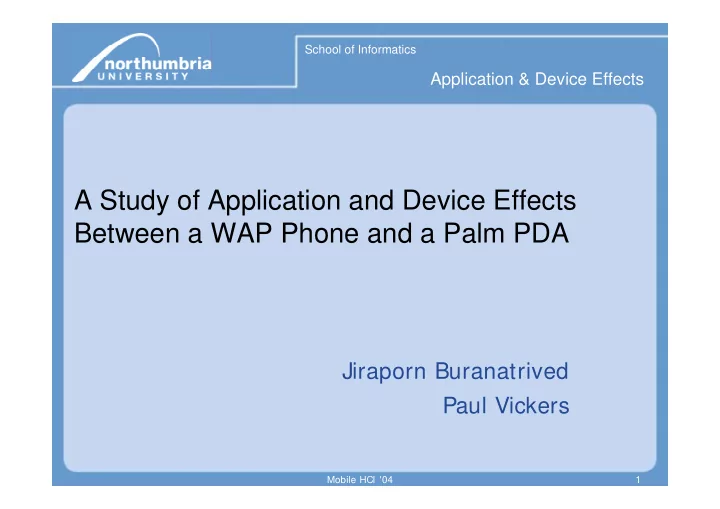

School of Informatics Application & Device Effects A Study of Application and Device Effects Between a WAP Phone and a Palm PDA Jiraporn Buranatrived Paul Vickers Mobile HCI '04 1
School of Informatics Application & Device Effects Mobile HCI '04 2
School of Informatics Application & Device Effects Background • Growth of mobile device market • More companies moving into mobile e-commerce, or m-commerce • Design for mobility has several success factors – Networking – Security – Application/ device mix – Usability Mobile HCI '04 3
School of Informatics Application & Device Effects Obstacles to consumer adoption Obstacle Phones PDAs Credit card security concerns 52% 47% Fear of ‘klunky’ user experience 35% 31% Don’t understand how it would work 16% 16% Other 11% 13% Never heard of it before 10% 12% * source http://www.epaynews.com/statistics/mcommstats.html# 36 Mobile HCI '04 4
School of Informatics Application & Device Effects Constraints • Screen size • Memory capacity • Processing power • Input/output modalities • Not as simple as squeezing existing applications into a smaller GUI Mobile HCI '04 5
School of Informatics Application & Device Effects Device heterogeneity • Applications require multi-platform availability • Devices have very different characteristics • Different usability issues for phones, PDAs, pocket PCs etc. • Began to study two application types running on two platforms – Ticket purchasing & stock broking – Mobile phone and Palm OS PDA Mobile HCI '04 6
School of Informatics Application & Device Effects Development • Used Java 2 Micro Edition (J2ME) to develop two applications – Movie ticket purchasing • Customer-led activity with server responding to client requests • Supports localisation – Stock broking • In addition to customer-led model has real-time event-driven aspect: customer reacts to stock price updates from server • Simulated the wireless communication – (even the network delays) Mobile HCI '04 7
School of Informatics Application & Device Effects Study • 16 subjects used both applications on both devices (4 tasks) • Performance measured by – Time – Error rate • Qualitative measures via a questionnaire • Subject workload measured by NASA TLX Mobile HCI '04 8
School of Informatics Application & Device Effects Task ordering Group Task order A1 1, 2, 3, 4 • Task 1: Phone broking A2 3, 1, 4, 2 • Task 2: PDA broking B1 2, 4, 1, 3 • Task 3: Phone ticketing B2 4, 2, 3, 1 • Task 4: PDA ticketing Mobile HCI '04 9
School of Informatics Application & Device Effects Procedure • Subjects given a workbook – Describing how to use the applications – Requirements for the 4 tasks – Task questionnaires – TLX rating sheets Mobile HCI '04 10
School of Informatics Application & Device Effects Data collection • Performance – Time taken – Error rate • Data used to calculate a task correctness score • TLX used to collect workload data Mobile HCI '04 11
School of Informatics Application & Device Effects Results • Task duration – Ticketing takes longer than stock purchasing, so cannot meaningfully compare times – Between devices the times were not significantly different for either application (F= 0.144, p> 0.05) – Times compare favourably with Fitt’s Law predictions except stock broking on the phone which took longer than predicted (t(15)= 2.265, p= < 0.05) • Network delays, or problem with applying Fitt’s law to wireless devices? Mobile HCI '04 12
School of Informatics Application & Device Effects Results: task error • Some difference in scores between both 95.70 96.00 application and device 95.50 Mean correctness (%) 94.53 95.00 94.50 93.75 – Two-way ANOVA 94.00 93.50 93.00 92.19 – No difference in scores 92.50 92.00 between application 91.50 91.00 90.50 or device, and no 90.00 Mobile Broking Mobile Ticket device/application interaction Mobile Phone effect revealed PDA Mobile HCI '04 13
School of Informatics Application & Device Effects Satisfaction • Phone had higher mean 80.00 78.19 User's Satisfaction (%) satisfaction rating 78.00 74.58 76.00 (not significant difference) 74.00 71.39 70.69 72.00 • Phone ticketing had 70.00 68.00 highest rating… 66.00 Mobile Broking Mobile Ticket • …yet the lowest accuracy score Mobile Phone PDA • Due to device familiarity? Mobile HCI '04 14
School of Informatics Application & Device Effects Ease of use and response • Applications had significant ease-of-use score differences. Not affected by device • Applications had significant response-satisfaction score differences. No device effect. • Suggests device may have less influence on user than the application – Get the app. right and any device will do? – Need more studies to explore this Mobile HCI '04 15
School of Informatics Application & Device Effects Workload 100 • NASA TLX ratings: Mean=43.13 Mean=48.44 Mean=29.44 Mean=25.44 – highly significant 80 application diff (p< 0.01) 60 – but not device * * 40 • Data entry on * * broking slightly 20 harder on phone? 0 N = 16 16 16 16 BrokingPDA BrokingPhone TicketPDA TicketPhone Mobile HCI '04 16
School of Informatics Application & Device Effects Usability in m-commerce • Phones are common, but no difference found in task duration, error rate, user satisfaction between devices • Application differences seemed more important than platform • Need to explore more complex tasks to look for device effects (e.g. list scrolling) • Alternative representations for different displays? Mobile HCI '04 17
Recommend
More recommend